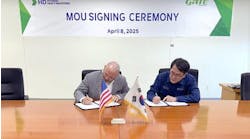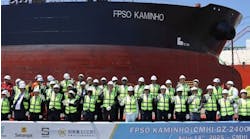All noisy on Nigeria's southeastern front
As Nigeria finalizes the joint development zone with the twin islands of Sao Tome and Principe in the Gulf of Guinea, the country is facing Cameroon in an epic border dispute at the World Court in The Hague. Neither of these countries has proven to be as rich in hydrocarbon resources as Equatorial Guinea, a neighbor to the southeast, with whom a border dispute has recently been resolved.
Considered a marginal condensate producer until 1995, Equatorial Guinea produced first oil in December 1996, 18 months after Mobil discovered hydrocarbons in the Zafiro Field. Today, the country is producing more than 150,000 b/d, a figure that is likely to reach 230,000 b/d by the end of the year. In February 2002, ExxonMobil, the largest producer in Equatorial Guinea, announced plans to boost production from the Zafiro Field complex in Block B to 185,000 b/d by the end of this year. In total, 19 wells will be drilled on the field in 2002, including eight wells from the Jade platform and 11 subsea wells, which will be tied back to a future floating, production, storage, and offloading (FPSO) vessel. Two additional mobile rigs will be brought to the area ahead of the 11-well program.
With a capacity to produce 110,000 b/d, the FPSO will be installed in late 2003 to drain the southern extension of the field, which is expected to contain as much as 130 MMbbl. One water injector has just been completed from the Jade platform (30,000 b/d of water), and one additional producer was to be completed by the end of March. In addition, a stepout well will be drilled, presumably in the southern sector of the field. ExxonMobil plans on spending $600 million in Block B in 2002. Ultimate recoverable reserves of the Zafiro complex are estimated at 1.2 Bbbl. The development of the northern portion of the field in the formerly disputed zone with Nigeria will be governed by the border treaty. The area is thought to contain 100 MMbbl.
Meanwhile, Amerada Hess, ExxonMobil's closest competitor in Equatorial Guinea, has announced that production from its Ceiba Field increased to over 50,000 b/d following flow resumption in late January after replacing the Sendje Berge with the better equipped Sendje Ceiba FPSO. The latter has expanded production and water injection facilities with 160,000 b/d processed, 135,000 b/d of water injected. New wells will be brought onstream later this year, and water injection has started.
Following the oil discovery made with wildcat F-2 at Ebano-1, the Glomar R.F. Bauer moved to its next location in the Rio Muni Basin, Block G, where it found oil in the Akom Field in 1,400 ft water depth with the G-7 wildcat. The Akom Field is downdip and 3 km northwest of the Oveng-1 oil discovery on the slope in the North Toe-Thrust area. Reservoirs are similar to those in Okume, Oveng, and Ebano nearby, for which joint development scenarios are being evaluated.
Nigerian licensing round delayed
Nigeria's Department of Petroleum Resources in Lagos said the next general licensing round for deepwater leases could be delayed into 2003. The licensing round was initially planned for September 2001, less than a year after the results of the 2000 rounds were announced, but the government unit responsible for lease awards has been quite busy.
For starters, negotiations on the production sharing contracts (PSCs) for the leases awarded during the 2000 licensing round dragged on for an entire year, finally ending in January 2002. Even so, some of the negotiations were inconclusive. Those who eventually signed the PSCs include ChevronTexaco (OPL 250), Petronas (OPL 242), Petrobras (OPL 324), and Oranto (OPL 320). In the negotiations for the plum lease OPL 214, Esso and Petronas had such major disagreements with the Nigerian government that the latter threatened to grant the award to state-owned Nigerian Petroleum Development Company. Second, the same unit of government is currently focused on another type of award - that of granting farm-in access to marginal fields (residing in acreages operated by the majors) to indigenous Nigerian investors following a bidding round that began in November 2001. This set of awards will not conclude until June 2002.
Seismic acquisition companies will benefit from this delay. The postponement, at least, allows enough time for completion and interpretation of all of the 3D speculative programs (PGS, Veritas DGC, and TGS-Nopec).
TFE pins hope on African deepwater giants
With the Girassol deepwater oil field in Angola reaching a production plateau of 200,000 b/d 10 weeks after first oil, TotalFinaElf (TFE) has signaled it will implement its plans to make Africa its growth area in the next five years. TFE operates Girassol Field in Block 17 with 40% interest.
The French supermajor is counting on large fields in deepwater Angola and Nigeria to deliver 200,000 b/d net production between 2000 and 2005. This is twice as much as the company's European and Middle East assets combined could hope to deliver. TFE wants to deliver 2.8 MMb/d worldwide by 2005, and Girassol certainly appears to be making its contribution to this target quota. Estimated at about 1 Bbbl in recoverable reserves, Girassol was put onstream in December 2001, three and a half years after the award of two turnkey contracts for development of the field and five years and seven months after the field's discovery. Initial production was restrained at a rate of about 15,000 b/d from two wells. By Jan. 26, 2002, production had jumped to an average of 186,000 b/d from seven wells. One of these wells was said to be producing 35,000 b/d.
TFE's second giant oil field in deep offshore Africa is Dalia with estimated recoverable reserves of 750 MMbbl. Another Block 17 find, it is scheduled to come onstream by 2005. A queue of other giant fields in this prolific block could hold a total of 1.6 Bbbl. TFE could run into difficulty putting this field in production in view of the Angolan government's philosophy of staggering oil field development to, as an official put it early in 2001, "preserve the huge reserves for future generations."




